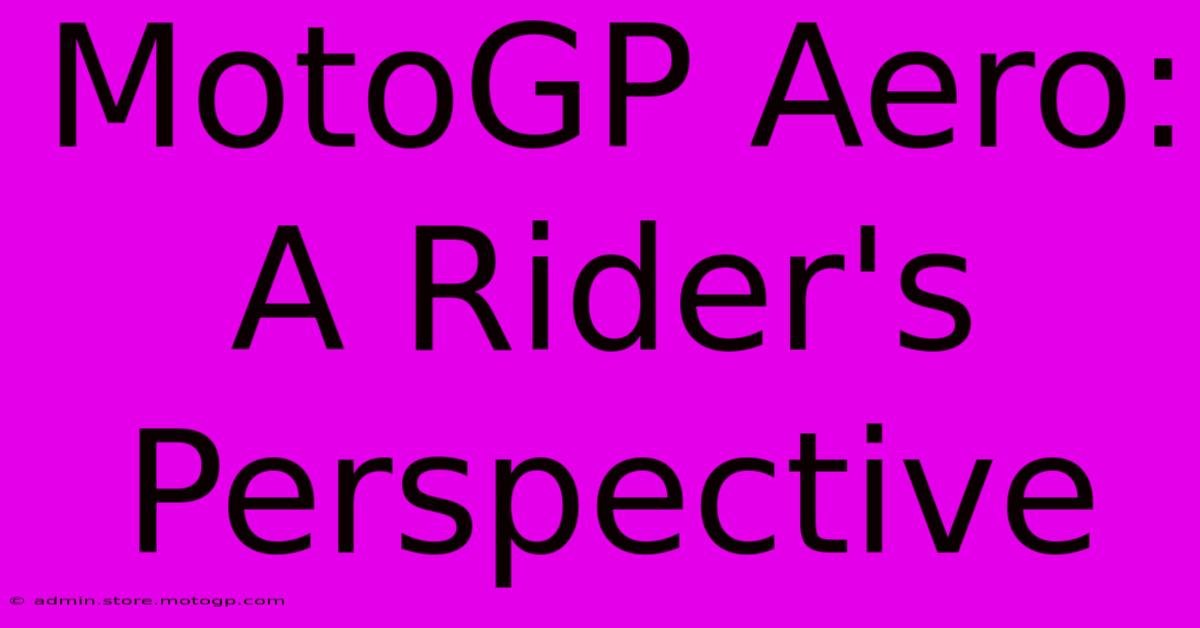MotoGP Aero: A Rider's Perspective

Table of Contents
MotoGP Aero: A Rider's Perspective
MotoGP racing is a relentless pursuit of speed and efficiency, and aerodynamics play a crucial role in achieving both. While the technical details are often complex, the impact of aerodynamic performance is directly felt by the rider. This article delves into the rider's perspective on MotoGP aero, exploring its influence on performance, riding style, and the overall racing experience.
The Importance of Downforce
At speeds exceeding 200mph, aerodynamic downforce isn't just an advantage; it's a necessity. Downforce, generated by carefully designed fairings, wings, and winglets, presses the bike to the track. This enhanced grip is paramount for several reasons:
- Increased Cornering Speed: Greater downforce allows riders to carry significantly higher speeds through corners, shaving precious seconds off lap times. The bike remains stable and planted, even when leaned over aggressively.
- Improved Braking Performance: The increased grip provided by downforce enhances braking stability, allowing for later braking points and more aggressive braking maneuvers.
- Enhanced Stability: High speeds and aggressive maneuvers create instability. Downforce acts as a stabilizing force, preventing unwanted wheelspin, slides, and loss of control.
Feeling the Difference
Experienced MotoGP riders can intuitively sense the difference between different aero packages. Small adjustments to wing angles or fairing designs can have a noticeable impact on the bike's handling. A rider might describe this as:
- Increased "Stickiness": The feeling of the tires clinging to the track with increased force.
- Improved Turn-in: The bike responding more quickly and precisely to steering inputs.
- Enhanced Stability under Acceleration: The rear wheel maintaining traction more effectively.
- Changes in Bike Balance: Different aero configurations might shift the balance of the bike, requiring adjustments to riding style.
The Challenges of MotoGP Aero
While beneficial, MotoGP aero presents its unique challenges:
- Increased Drag: The very components generating downforce also increase drag, slowing the bike on straights. This necessitates a delicate balance between downforce and drag reduction.
- Heat Management: Fairings and wings can restrict airflow, leading to increased temperatures around the engine and other vital components. Effective cooling solutions are crucial.
- Complexity and Adjustment: Modern MotoGP aero packages are sophisticated and require meticulous adjustments based on track characteristics, weather conditions, and riding style.
- Physical Demands: The increased downforce can exert significant physical force on the rider, requiring exceptional strength and stamina to control the bike.
Rider Feedback: A Crucial Element
Rider feedback is indispensable in the development and refinement of MotoGP aero. Riders provide invaluable insights into how different aero configurations feel and perform on the track. This iterative process of design, testing, and feedback is essential for optimizing aerodynamic performance.
The Future of MotoGP Aero
The pursuit of aerodynamic advantage is ongoing. We can expect continued innovation in MotoGP aero, with ever-more sophisticated designs pushing the boundaries of performance. The interplay between rider skill, machine technology, and aerodynamic design will remain central to the thrilling spectacle of MotoGP racing. Expect to see further advancements in:
- Adaptive Aerodynamics: Systems that dynamically adjust aero components based on speed and track conditions.
- Computational Fluid Dynamics (CFD): Increased use of CFD modeling to optimize designs and reduce the need for extensive physical testing.
- Material Innovation: The use of lighter and stronger materials to minimize weight while maximizing aerodynamic performance.
The rider's perspective on MotoGP aero is crucial in unlocking the full potential of these advancements. The constant collaboration between riders, engineers, and designers ensures that MotoGP bikes remain at the forefront of motorsport technology.

Thank you for visiting our website wich cover about MotoGP Aero: A Rider's Perspective. We hope the information provided has been useful to you. Feel free to contact us if you have any questions or need further assistance. See you next time and dont miss to bookmark.
Featured Posts
-
Cota Parking The Best Cota Parking Tips
Feb 18, 2025
-
Experience The Atmosphere Motorcycle Race Austin Tx
Feb 18, 2025
-
Moto Gp Photoshoot The Legacy Of Moto Gp
Feb 18, 2025
-
Moto 2 Specs Are They Worth The Hype
Feb 18, 2025
-
Moto Gp Crash Today From Despair To Hope
Feb 18, 2025
